Application Fields of Infrared Thermography
There is more to this world than can be seen with the naked eye. The human eye is only capable of capturing certain light ranges and is also limited in its ability to capture certain high-speed movements or invisible forces. From the heat of a human body to invisible gases, human sight has limitations that can be solved by infrared and thermal imaging technology.
Below you can learn more about the basics of infrared cameras and thermal imaging. In addition to reading more about the basic tenets of the field, you'll learn more about some of the exciting and commonplace applications of infrared cameras in the world today.
What is Infrared and Thermal Imaging?
The human eye, as mentioned above, is only capable of capturing a very small portion of the greater electromagnetic spectrum. Short, intense wavelengths of light and long, slow wavelengths are outside the capability of the human eye. This is where infrared cameras and thermal imaging can fill in the gaps in human sight. Thermal energy has a much longer wavelength than visible light. It is so long in fact that the human eye can't even see it.
Thermal imaging with infrared cameras expands the "visible" spectrum of the human eye by doing the work an eye cannot. It perceives these longer wavelengths and captures them in a color-coded world that the human eye can understand. Everything in the world with a temperature above that of absolute zero emits some level of heat which can be detected and measured.
FLIR
Also known as Forward Looking Infrared, these cameras are very common in police helicopters, military aircraft to spot heat sources and displayed via video output. FLIR cameras are very different from other night-vision devices and conventional infrared cameras however, since these only display a certain infrared range.
Telops offers a flexible thermography software for every application field, stationary or mobile, thus satisfying the most specific of customer demands.
Active Thermography for Non-Destructive Material Testing
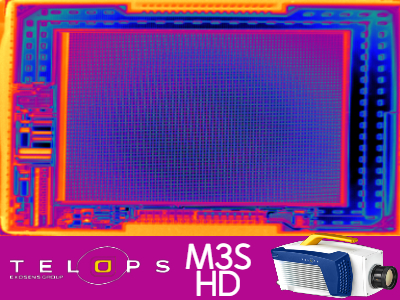
crisp image of an iPhone's print ID button was taken with a FASTM3S HD camera
Active thermography is mostly referred to as induction of a heat flow by energetically exciting a test object. Heat flow is influenced by interior material layers and defects, which can be captured by high-precision infrared cameras. This makes different evaluation of algorithms and improves the signal-to-noise-ratio which detects even the smallest defect. The uses in this field include:
- Non-destructive and contact-free material testing, for both automated in-line and off-line solutions
- Detection of layer structures, delamination and inserts in plastics
- Detection in CFRPs of the automotive and aerospace industry
- Investigation of interior structures or impacts on honeycomb lightweight constructions
- Recognition of deeper material deficiencies, such as blowholes in plastic parts or ruptured laser welding seams
View our recommended infrared camera for this application, the Fast M3S HD MWIR camera
Aerial Thermography
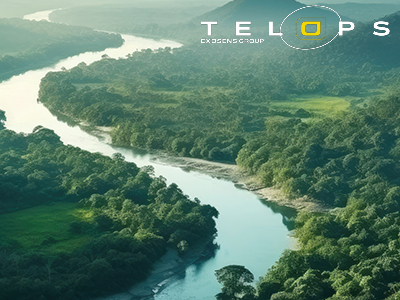
Environmental observation and monitoring are essential
Aerial Thermography’s history begins with military applications starting as early as the Korean war, used to detect enemy forces and resources on the ground. High geometrical resolution of the infrared camera system allows detection of even the smallest detail from a great height, which can then be used for both observation and monitoring. While this is always being developed by the US military for continuous improvement, these are some examples of its varied usage within other fields:
- Enhance the visual clarity of small items on the ground
- Assess the extent of environmental damages without risking human lives
- Fast infrared camera systems offer low smearing
- Integration of GPS data and visual images
- Wide range of accessories like gimbal systems
- Monitor large geologic properties for changes
- Inspect the thermal storage capabilities of biotops on industrial complexes
View our recommended infrared camera for this application, the Hyper-Cam Airborne Mini
Thermography in Aerospace Industry
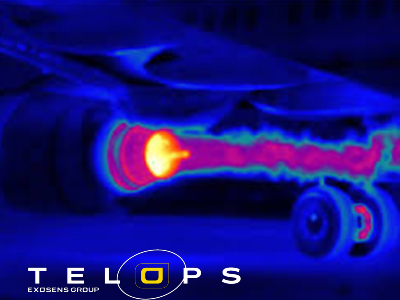
Take-off of an Jet Airplane
Aerospace sets the greatest demands on Infrared camera systems due to the high safety and material requirements presented. Often, high thermal resolutions of 20 mk and/or high frame rate of 100 Hz and more are necessary. Aerospace firms can use thermography to test active heat flows on new composite materials to ensure the next generation of lighter, more fuel-efficient aircraft remain as safe as today's models.
View our recommended infrared camera for this application, the HDR M700 MWIR camera
Thermography in Automotive Industry
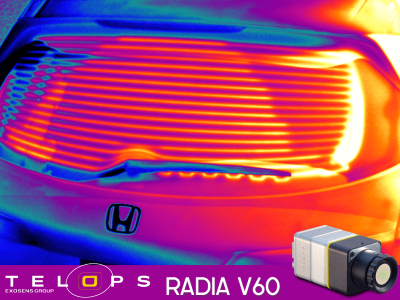
Thermal analysis of a window defroster generating a strip heat pattern
Deconstructing parts of the car can be cumbersome, and thermography offers a non-invasive and non-destructive approach testing which saves time and effort. Tight competition and the chase for better performing, fuel-saving, and lighter automobiles inspires thermography to provide the needed efficiency through doing quality checks on every electrical system, motor assemblies and window heating elements. It provides detection of defects and deficiencies of multiple products for the automotive industry only detected through temperature changes and allows reconciliation of thermal behavior of components with their standard behavior.
View our recommended infrared camera for this application, the RADIA V60 LWIR camera.
High-Speed Thermography
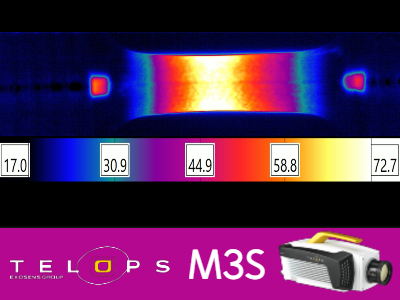
High-Speed Infrared Imaging of a Split-Hopkinson Pressure Bar
High speed image capturing opened doors to new possibilities in thermal imaging, allowing observation of high-speed thermal processes. This allows for minute observation of parts and systems and helps in understanding rapid acting chemical processes and combined with powerful measurement and reporting software provides a vast wealth of information. These cameras utilize special detectors and acquisition units called snapshot detectors, and their ability to acquire and display data in parallel provides precise thermographic measurements down to the millisecond range.
Thermography in Chemical Industry
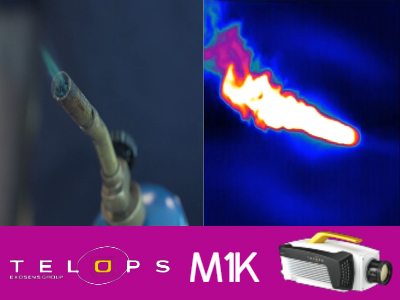
Thermal Analysis of a Gas Torch.
Industries dealing with hazardous and non-hazardous chemical materials can benefit from infrared cameras helping to detect the resulting heat flow from chemical processes. Thermal imaging makes it easier to capture and measure the temperature distribution with greater accuracy, and also enable the analysis of chemical reactions through the entire process chain. Best of all, the non-invasive and contactless nature of thermal imaging means people are kept at a safe distance while thermal imaging cameras do all the legwork to collect relevant data.
View our recommended infrared camera for this application, the Fast M1K MWIR camera.
Thermography in Electronics and Electrical Industry
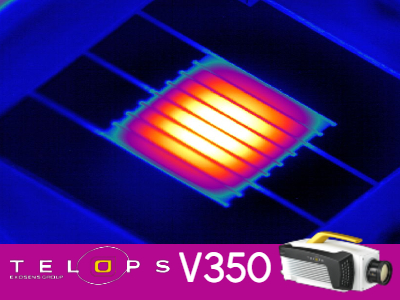
Thermal analysis of heat dissipation for a resistor.
Electrical systems and electrical distribution equipment can benefit from the application of infrared cameras and thermography technology. Not only does it prevent humans from having direct contact with these systems and circuits, testing and detection can be conducted without interrupting the flow of power. Common problems that can be detected in the electrical field courtesy of infrared imaging include:
- Loose connections
- Poor contacts
- Overheated bushings
- Blocked cooling passages
In the semiconductor and solar industries, quality inspection is crucial to ensuring the reliability and performance of end products. Advanced infrared imaging technologies, such as SWIR and photon emission microscopy, play a vital role in detecting defects and impurities in materials like silicon and semiconductor wafers. By identifying flaws early in the manufacturing process, these inspection techniques help optimize product yield and reduce potential failures, ultimately supporting efficient, high-quality production. Our advanced imaging solutions, utilizing UV, SWIR, and LWIR technologies, deliver early defect detection to ensure superior wafer quality. By addressing imperfections early, we help optimize production efficiency, reduce rework costs, increase yield, and maximize throughput, ultimately enhancing equipment ROI.
From UV to LWIR, our comprehensive wavelength capabilities provide the versatility needed for precise semiconductor inspection.
- UV (Ultraviolet 190 to 400 nm): Delivers unmatched precision for detecting microscopic surface defects at the nanometer scale.
- SWIR (Short-Wave Infrared 0.9 to 1.7μm): Leverages silicon’s transparency for precise alignment in stacking, bonding, and packaging.
- LWIR (Long-Wave Infrared 8 to 12μm): Monitors thermal patterns and ensures uniformity, enabling real-time process adjustments and reducing downtime.
View our recommended infrared camera for this application, the Fast V350 LWIR camera
Inspections of Mechanical Components
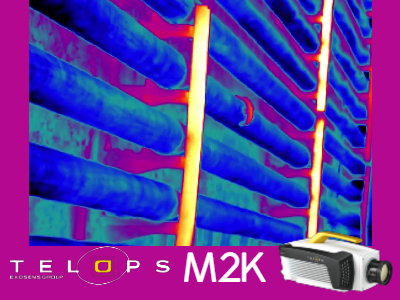
Inspection of Petrochemical Furnaces.
Infrared cameras can safely inspect mechanical systems from various industries to detect issues before they become major problems. Thermal imaging applications as it pertains to mechanical inspections are diverse and include, but are not limited to:
- Detecting blocked air coolers and radiator tubes in internal combustion engines
- Finding air leaks and clogged condenser tubes in refrigeration systems
- Locate and identify overheating bearings, increased discharge temperatures, and excessive oil temperatures in pumps, compressors, fans, and blowers
View our recommended infrared camera for this application, the FAST M2K MWIR camera
Thermography for Material Testing
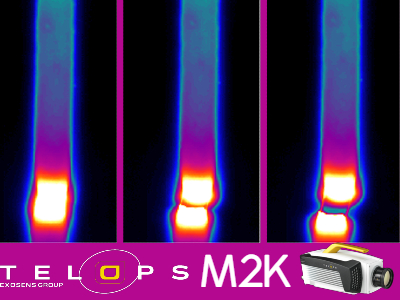
Tensile testing of a steel rod observed in infrared using Telops FAST M2k
Infrared thermography cameras offer a powerful alternative when studying structural situations or testing materials in a non-destructive manner. Since everything in this world emits infrared as long as its temperature is above absolute zero, non-destructive material testing is possible with infrared because it can capture measurements and readings from any surface upon which heating or cooling takes place. Using infrared cameras for thermal imaging in these settings is not only non-destructive, it is non-invasive as well.
Researchers typically carry out many different measurements like tensile displacement tests, compression tests and fatigue tests using extensometer and split-Hopkinson bars setups. Infrared imaging allows to characterize the energy released by the investigated material as it undergoes elastic and plastic deformation up to the fracture point.
View our recommended infrared camera for this application, the FAST M2K MWIR camera
Thermography in Ballistics
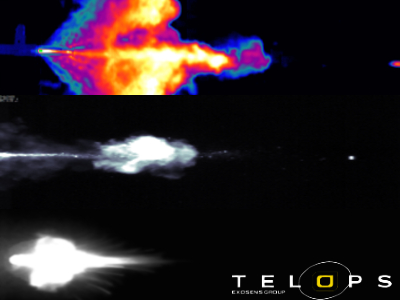
Infrared muzzle flash analyses
High-speed infrared cameras can be very useful for ballistic studies, as they allow to perform terminal ballistic, aeroballistic, and muzzle flash analyses. Projectiles in trajectory, flight behavior, aerodynamics, impact and launching can all be observed with thermal image data. IR data is valuable from the velocity impact of amour to study and characterize different material to understand reaction, deformation, and damage. High-speed IR cameras can capture the thermal behavior of muzzle flash, including its progression through various stages, revealing details about the combustion process and potential issues like incomplete powder burn.
View our recommended infrared camera for this application, the Fast M3K high speed MWIR camera
Infrared Signature & Ranging
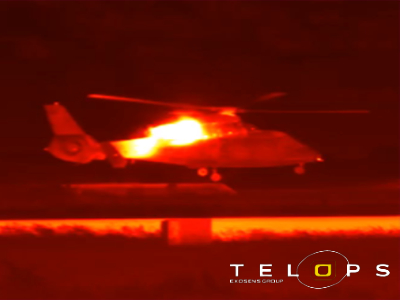
Infrared signature of a helicopters exhaust
Accurate in-band thermal radiance measurements for target detection, identification and recognition.
Efficient characterization of military target infrared (IR) signature plays an important role in any countermeasure defense program for the design of unmanned monitoring systems capable of ranging and tracking different targets as well as performing automatic detection and recognition of potential threats. In order to do so, large IR signature databases are built upon testing of multiple targets such as camouflage materials under various backgrounds conditions, at multiple wavelengths, and using different sensor technologies.
View our recommended infrared camera for this application, the Fast M3S HD MWIR camera
Infrared Cameras for Plant Inspections
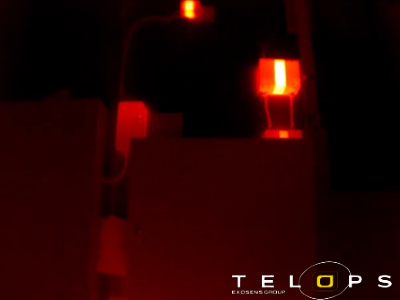
Inspection of a transformer
LWIR cameras are widely used in highly demanding applications such as process monitoring and industrial machine vision. Their ability to capture accurate and stable measurements with high resolution allows precise thermal inspection, large-surface analysis, and efficient data collection. By detecting temperature variations, LWIR cameras enable early identification of equipment anomalies, ensuring optimal process functionality and reducing downtime.
High-performance LWIR cameras (8 to 12 μm) designed for detecting thermal images with high accuracy. These cameras provide not only temperature measurements but also precise spatial information, making them indispensable for building and infrastructure inspections, water leak detection, gas detection and process monitoring. With a larger field of view, they enable the inspection of extensive areas, increasing system throughput. Their compatibility with advanced software and industrial standards ensures easy content analysis, seamless operation, and integration into existing systems.
View our recommended infrared camera for this application, the RADIA V60 LWIR camera
